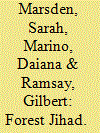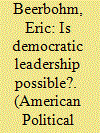| Srl | Item |
| 1 |
ID:
132226


|
|
|
|
|
| Publication |
2014.
|
| Summary/Abstract |
Despite increasing concern over the potential threat from "forest jihad," there has been no systematic attempt to assess whether such attacks are in fact taking place. Drawing on principles from the geospatial profiling of terrorist events, fire-risk prediction data, and information on jihadist convictions, this article offers a thorough review of the evidence to address this question. The available information suggests that so far, jihadists have not attempted to attack North American or European wildlands by means of arson. Despite calls for "popular resistance terrorism" in the jihadist literature, and the apparently low costs associated with this type of attack, jihadists have so far shown little appetite for "forest jihad."
|
|
|
|
|
|
|
|
|
|
|
|
|
|
|
|
| 2 |
ID:
143137


|
|
|
|
|
| Summary/Abstract |
Leadership can baffle our ideal of democracy. If representatives track our preferences, actual or ideal, what room is left for them to pushback against a constituency? This has led some political theorists to conclude that the concept of democratic leadership is paradoxical. I challenge this view by constructing a theory that takes shared commitment as its principal ingredient. The Commitment Theory brings out what is morally distinctive about leadership in a representative democracy. In principle, democratic leadership recruits citizens as genuine partners in shared political activity. The account explains why leadership is taken to be a core property of a functioning democracy and, at the same time, a potential threat to the practice. It is then tested against cases of opinion formation, cue-taking, and frame manipulation. I conclude that the theory avoids dual objections: that it either overcounts or undercounts instances of democratic leadership.
|
|
|
|
|
|
|
|
|
|
|
|
|
|
|
|